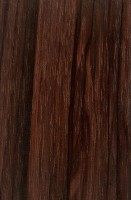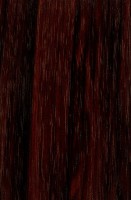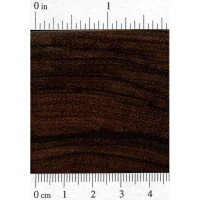Brazilian Rosewood
Color/Appearance: Brazilian Rosewood can vary in color from a darker chocolate brown to a lighter purplish or reddish brown, with darker contrasting streaks. The black streaks can sometimes form a unique grain pattern that is sometimes referred to as “spider-webbing” or “landscape,” very similar toZiricote. Lighter yellowish sapwood is clearly demarcated from the heartwood.
Grain/Texture: Brazilian Rosewood has a uniform, medium to coarse texture with medium-sized open pores. The grain tends to be straight, but can occasionally be interlocked, spiraled, or wavy.
Endgrain: Diffuse-porous; medium to large pores in no specific arrangement; solitary and radial multiples of 2-3; mineral deposits occasionally present; growth rings indistinct; rays not visible without lens; parenchyma banded (seemingly marginal), apotracheal parenchyma diffuse-in-aggregates, paratracheal parenchyma vasicentric, sometimes weakly aliform.
Rot Resistance: Heartwood is rated as very durable to decay resistance, and is also resistant to insect attack.
Workability: Easy to work with both hand and machine tools, though it may have a slight blunting effect on cutting edges. Brazilian Rosewood turns, and finishes well, though it can sometimes be difficult to glue due to its high natural oil content.
Odor: Has a distinct, rose-like scent when being worked.
Allergies/Toxicity: Although severe reactions are quite uncommon, Brazilian Rosewood has been reported as a sensitizer. Usually most common reactions simply include eye and skin irritation. See the articles Wood Allergies and Toxicity and Wood Dust Safety for more information.
Pricing/Availability: Likely to be very expensive, and from questionable sources. Trade of Brazilian Rosewood is highly regulated, and sales are generally limited to reclaimed or pre-existing pieces of lumber.
Sustainability: This wood species is in CITES Appendix I, and is on the IUCN Red List. It is listed as vulnerable due to a population reduction of over 20% in the past three generations, caused by a decline in its natural range, and exploitation.
Common Uses: Veneer, fine furniture, cabinetry, flooring, musical instruments (acoustic guitars, piano cases, etc.), turned objects, and other small wooden specialty items.
Comments: Brazilian Rosewood, like other exploited hardwoods such as Cuban Mahogany or Teak, has earned worldwide fame. Historically, it has perhaps been the species most frequently associated with the term “Rosewood,” and with its strength, hardness, stability, beauty, and acoustic properties, it’s easy to see whyDalbergia nigra has been used for everything from flooring to xylophone keys.
Due to the high demand and limited supply of Brazilian Rosewood, and its continued exploitation in recent decades, it has been listed in the most restrictive category of endangered species: CITES Appendix I. Not only is the lumber restricted from being imported or exported from country to country, but evenfinished products made of Brazilian Rosewood may not cross international boundaries.
Because of these heavy (yet justifiable) restrictions, several substitutes from theDalbergia genus have been used in recent years, such as East Indian Rosewood,Honduran Rosewood, and Cocobolo; though perhaps the closest rosewood in terms of color and appearance may be Amazon Rosewood (Dalbergia spruceana)—another hard-to-find and pricey rosewood, though not CITES listed as Brazilian Rosewood.
Related Species:
- African Blackwood (Dalbergia melanoxylon)
- Amazon Rosewood (Dalbergia spruceana)
- Bois de Rose (Dalbergia maritima)
- Burmese Blackwood (Dalbergia cultrata)
- Burmese Rosewood (Dalbergia oliveri)
- Cocobolo (Dalbergia retusa)
- East Indian Rosewood (Dalbergia latifolia)
- Honduran Rosewood (Dalbergia stevensonii)
- Kingwood (Dalbergia cearensis)
- Madagascar Rosewood (Dalbergia baronii)
- Sissoo (Dalbergia sissoo)
- Tulipwood (Dalbergia decipularis)
- Yucatan Rosewood (Dalbergia yucatensis)
 Brazilian Rosewood (sanded) Brazilian Rosewood (sanded) |
 Brazilian Rosewood (sealed) Brazilian Rosewood (sealed) |
 Brazilian Rosewood (endgrain) Brazilian Rosewood (endgrain) |
 |
